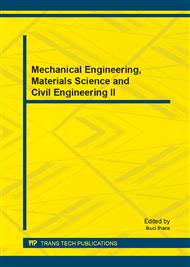p.124
p.128
p.132
p.137
p.141
p.146
p.150
p.154
p.158
Preparation and Characterization of UV Curable Hybrid System Based on Free Radical and Cationic Mechanism
Abstract:
A UV curable hybrid system with a dual mechanism of radical and cationic photo-polymerization, was investigated. A kind of free radical oligomer with low viscosity named hexahydrophthalic acid diglycidyl acrylate was first synthesized. The structure of the oligomer was characterization by FTIR. The UV curing processing of hybrid system was traced by real-time FTIR, and compared with free radical, cationic system. Thermal decomposition temperature and glass transition temperature of UV curing film for various system were determined by thermogravimetric analysis (TGA) and differental scanning calorimetry (DSC), respectively. And physical and mechanical properties of those curing films were analyzed and compared. The results show that the radical polymerization of double bond and cationic polymerization of epoxy group could occur simultaneously in hybrid system. The conversion rate of epoxy group for hybrid system was higher than that of epoxy group for cationic system, which demonstrated that the cationic photo-initiator (DPI·PF6) can be sensitized by the free radical photo-initiator (Irgacure 184). Compared with free radical and cationic system, the hardness and mechanical properties of hybrid system curing film were better than those of the cationic system curing film, while closed to those of free radical system.
Info:
Periodical:
Pages:
141-145
Citation:
Online since:
December 2013
Authors:
Price:
Сopyright:
© 2014 Trans Tech Publications Ltd. All Rights Reserved
Share:
Citation:


